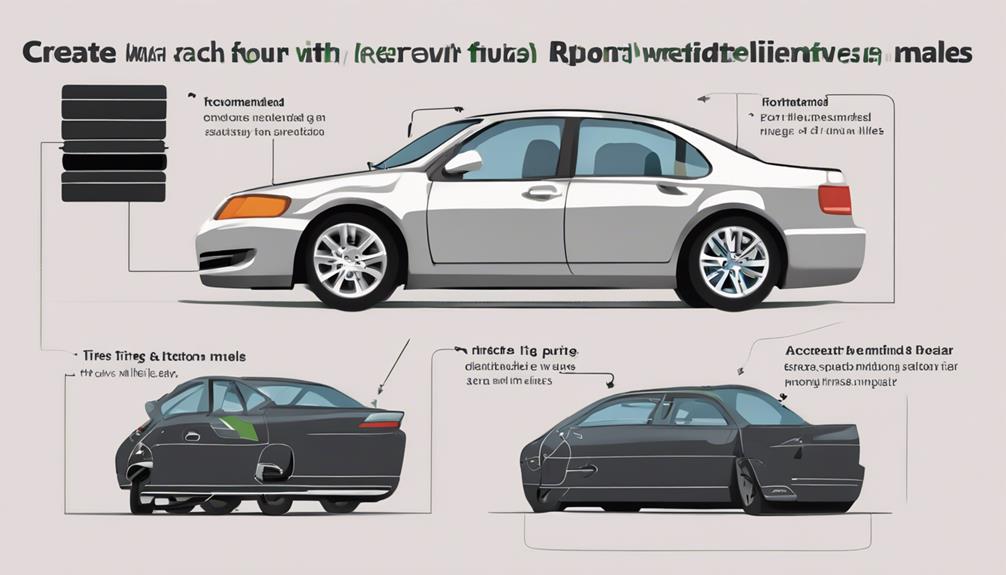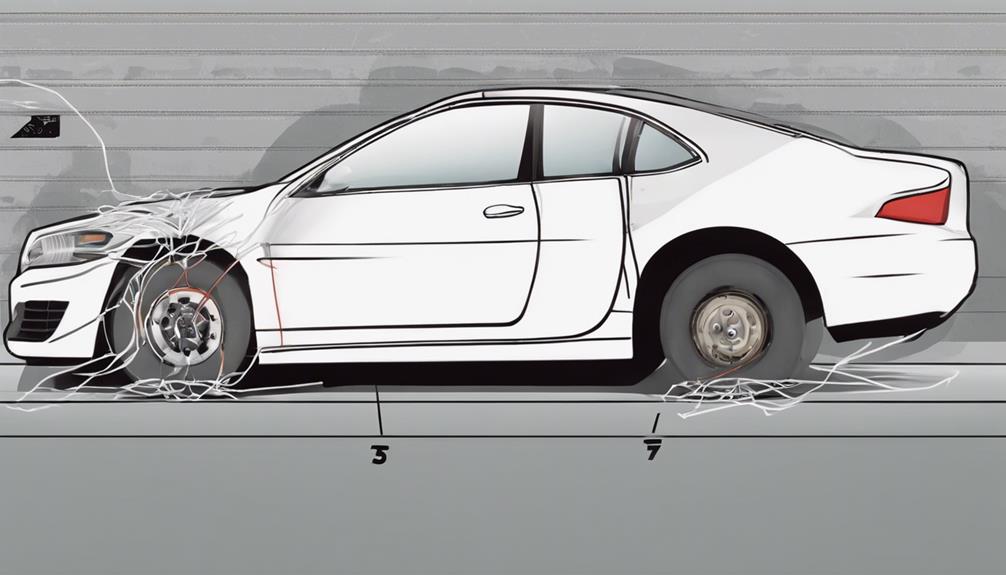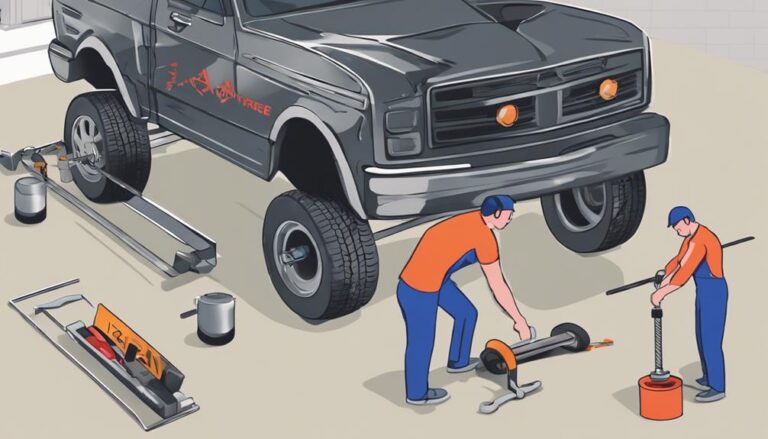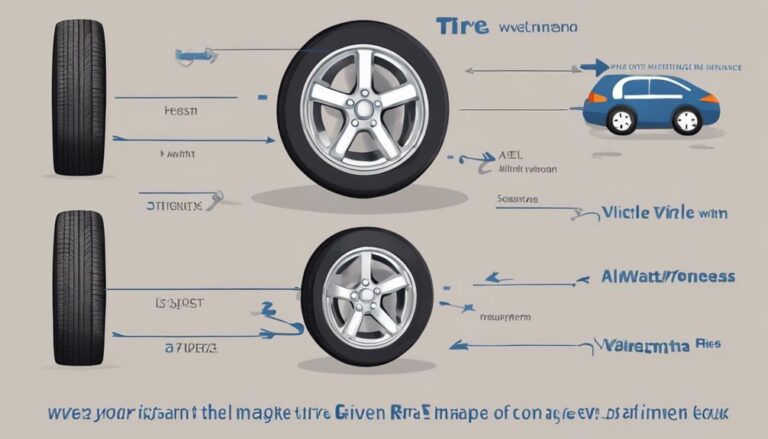Optimizing Tire Rotation and Alignment for Your Car
Did you know that improper tire alignment can reduce your fuel efficiency by up to 7%?
Ensuring your tires are rotated and aligned correctly is not only crucial for your safety but also for maximizing the lifespan of your tires.
By following a few simple guidelines and understanding the importance of these maintenance tasks, you can significantly improve your driving experience and save money in the long run.
Key Takeaways
- Regular rotation and alignment enhance tire lifespan and vehicle safety.
- Adhering to maintenance schedules saves money and optimizes tire performance.
- Recognizing alignment issues early prevents uneven wear and costly replacements.
- Neglecting rotation and alignment impacts handling, safety, and overall vehicle efficiency.
Importance of Tire Rotation Frequency
Regularly rotating your tires, typically every 5,000 to 7,000 miles, is essential for maintaining optimal wear performance and extending the lifespan of your tires. Adhering to this maintenance schedule brings forth a multitude of benefits. Firstly, by rotating your tires, you ensure that wear characteristics remain even across all tires. This even wear distribution directly translates to enhanced performance on the road. Uneven wear can lead to decreased traction, affecting your vehicle's handling and safety.
Additionally, proper tire rotation plays a pivotal role in the longevity of your tires. Over time, tires wear out unevenly if not rotated, resulting in premature replacement and added costs. By following the recommended rotation frequency, you counteract these adverse effects, maximizing the lifespan of your tires. Therefore, consistent tire rotation isn't just about maintenance; it's about optimizing the performance and longevity of your tires, ultimately providing you with a smoother and safer driving experience.
Factors Influencing Alignment Frequency
Factors influencing alignment frequency vary based on driving habits, road conditions, and vehicle type. Aggressive driving styles, encountering potholes frequently, and driving on rough terrains can lead to misalignments, necessitating more frequent adjustments. Different vehicle types may also require varying alignment frequencies due to factors like weight distribution and suspension design. Regular maintenance, such as checking tire wear patterns and consulting with professionals, can help determine when an alignment is needed.
| Factors Influencing Alignment Frequency | Description |
|---|---|
| Driving Conditions | Aggressive driving, rough terrains, potholes |
| Vehicle Type | Cars, SUVs, trucks, sports cars |
| Maintenance | Regular tire wear pattern checks, professional consultations |
Understanding these factors and monitoring your driving conditions and maintenance routines can help you determine the ideal alignment frequency for your vehicle, ensuring optimal performance and tire longevity.
Recommended Tire Rotation Intervals

For optimal wear performance and extended tire lifespan, adhering to recommended tire rotation intervals is crucial according to automotive experts. Tire rotation intervals typically range from every 5,000 to 7,000 miles to ensure even wear distribution across all tires. Following the rotation schedule outlined in your vehicle owner's manual is essential to maximize rotation benefits.
By rotating your tires, you help counteract uneven wear characteristics, promoting a longer tire lifespan. Regular rotations every few months prevent premature wear on specific tires, leading to a more balanced tire wear pattern over time.
To benefit from proper tire rotation, make it a priority to visit a trusted tire dealer or automotive service center. These professionals have the expertise to perform the rotation correctly, ensuring that your tires wear evenly. By adhering to the recommended rotation intervals, you not only improve overall tire performance but also save money in the long run by extending the life of your tires.
Signs Your Car Needs Alignment
To determine if your car needs alignment, closely monitor signs such as uneven tread wear on your tires and any pulling to the left or right while driving straight. Additionally, an off-center steering wheel when driving straight and vibrations felt in the steering wheel are indicators of misalignment. Addressing these issues promptly can prevent further tire wear and ensure optimal vehicle performance. If you suspect alignment problems, there are both DIY alignment methods and professional services available to correct the issue. DIY methods can be cost-effective but may not provide the same precision as professional services. When considering alignment, budget for the alignment cost and factor it into your overall maintenance expenses. Being proactive in recognizing these signs and addressing alignment concerns promptly can save you money in the long run by avoiding more extensive repairs due to neglected alignment issues.
| Signs Your Car Needs Alignment | |
|---|---|
| Uneven tread wear on tires | Pulling to left or right |
| Off-center steering wheel | Vibrations in steering wheel |
Impact of Neglecting Rotation and Alignment

Neglecting proper tire rotation and alignment maintenance significantly impacts your vehicle's performance and safety, leading to potential hazards and increased costs in the long run.
Failure to rotate your tires regularly can result in uneven tire wear, reducing their lifespan by up to 50%. This uneven wear not only decreases tire longevity but also affects your vehicle's performance and handling, compromising safety on the road.
Additionally, disregarding alignment issues can lead to premature tire replacements, adding unnecessary costs to your maintenance expenses. Ignoring the need for balancing can cause vibrations, which not only contribute to uneven tread wear but also result in discomfort during drives.
Furthermore, neglecting alignment maintenance can impact various aspects of your vehicle, including handling, fuel efficiency, and overall safety. By not optimizing tire rotation and alignment, you risk increased wear, decreased performance, and potential safety hazards, underlining the importance of regular maintenance for your vehicle's well-being.
Frequently Asked Questions
Should You Get a Tire Rotation and Alignment at the Same Time?
You should definitely get a tire rotation and alignment at the same time. This proactive approach optimizes tire wear and handling. It's a smart maintenance schedule that maximizes benefits and minimizes costs in the long run.
Does Tire Rotation Include Alignment?
Tire rotation does not include alignment. Rotation focuses on even wear distribution through various techniques. Alignment benefits correct wheel angles for tracking and steering precision. Combining both services ensures optimal tire health. Regular checks are essential for performance longevity.
Does Rotating Your Tires Really Help?
Rotating your tires is like giving them a rejuvenating spa day. It's a crucial maintenance step that combats uneven tire wear and keeps your car running smoothly. Stick to your maintenance schedule for optimal performance.
Do You Need to Rebalance Tires After Rotating?
If you notice vibrations or uneven tire wear post-rotation, consider checking balance. Factors like tire wear patterns and driving conditions influence rebalancing need. Correct weight imbalances caused by wear or driving changes to maintain optimal performance.
Conclusion
In conclusion, just as a well-oiled machine requires regular maintenance to function smoothly, your car's tires also need proper care. Ensuring optimal tire rotation and alignment is like giving your car a tune-up, keeping it running efficiently and extending its lifespan.
By following recommended intervals and addressing alignment issues promptly, you'll not only save money on premature tire replacements but also enjoy a smoother, safer driving experience. Prioritize your tire care for a smoother ride ahead.







